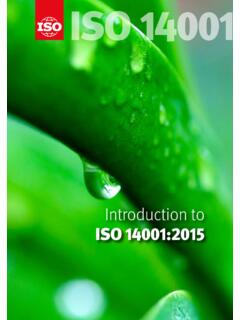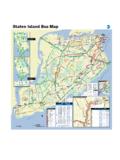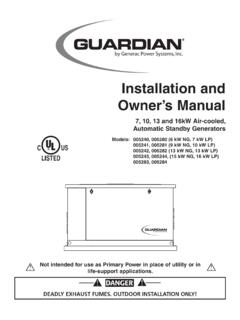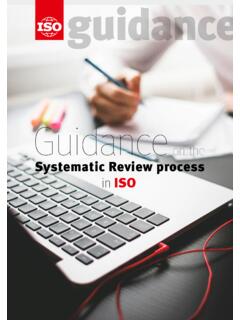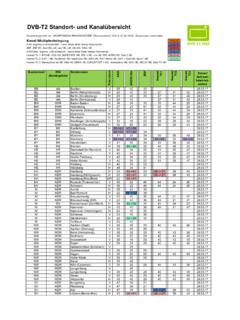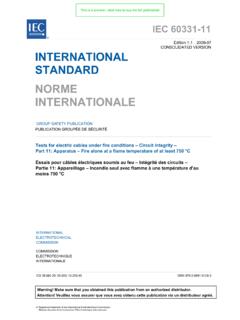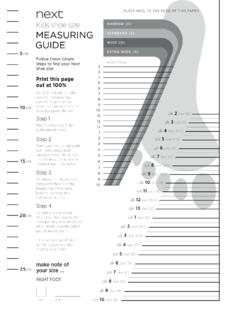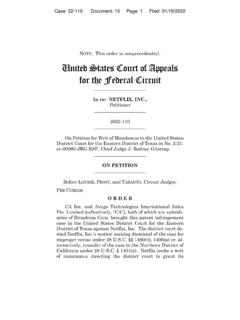Transcription of American Softwood Lumber Standard
1 American Softwood Lumber StandardVoluntary Product Standard PS 20-15 April 2015 Supersedes Voluntary Product Standard PS 20-10 Voluntary Product Standard PS 20-1 5 American Softwood Lumber Standard Supersedes Voluntary Product Standard PS 20-10 April 2015 Department of Commerce Penny Pritzker, Secretary National Institute of standards and Technology Willie E. May, Acting Under Secretary of Commerce for standards and Technology and Director This page is intentionally left blank. 2 VOLUNTARY PRODUCT standards Development of Voluntary Product standards Voluntary Product standards are developed under procedures published by the Department of Commerce in Title 15 Code of Federal Regu-lations Part 10, Procedures for the Development of Voluntary Product standards .
2 The purpose of these standards is to establish nationally rec-ognized requirements for products and provide all concerned interests with a basis for common understanding of the characteristics of the products. The National Institute of standards and Technology (NIST) administers the Volun-tary Product standards Program on a reim-bursable basis. Role of NIST The role of NIST in the establishment of Volun-tary Product standards is to act as an unbiased coordinator in their development, provide edito-rial assistance in their preparation, supply such assistance and review as is required to assure their technical soundness, and to seek satisfac-tory resolution of valid points of disagreement. NIST also determines compliance with the cri-teria of the Department s procedures, provides secretarial functions for each committee ap-pointed under the procedures, and publishes the standards as public documents.
3 Producers, distributors, users, consumers, and other interested groups contribute to the estab-lishment of Voluntary Product standards by in-itiating and participating in their development, providing technical or other counsel as appro-priate, promoting the use of and support for the standards , and assisting in keeping the stand -ards current with respect to advancing technol-ogy and marketing practices. Use of Voluntary Product standards The use of Voluntary Product standards is vol-untary. NIST has no regulatory power in the enforcement of their provisions: however, since the standards represent a consensus of all in-terested groups, their provisions are likely to become established as trade customs. In addi-tion, when a Voluntary Product Standard is made a part of a legal document, such as a sales contract or code, compliance with the Standard is enforceable.
4 The benefits derived from Voluntary Product standards are in direct proportion to their gen-eral recognition and actual use. Producers and distributors whose products meet the require-ments of a Voluntary Product Standard may re-fer to the Standard in advertising and on labels to promote greater public understanding for confidence in their products. At times, purchas-ers may order products conforming to the re-quirements of a Voluntary Product Standard . For copies of the Voluntary Product standards procedures or for more information concerning the development and use of these standards , contact the standards Services Division, Na-tional Institute of standards and Technology, Gaithersburg, MD 20899-2100. 3 This page intentionally left blank.
5 4 Voluntary Product Standard PS 20-15 (Supersedes Voluntary Product Standard PS 20-10) American Softwood Lumber Standard PREFACE The American Softwood Lumber Standard was developed by the American Lumber Standard Committee (ALSC) in accordance with the Procedures for the Development of Voluntary Product standards of the Department of Commerce. The ALSC membership is appointed by the Secretary of Commerce to constitute a proper balance among producers, distributors, and consumers of Softwood Lumber . Pursuant to a District Court order, the ALSC and its Board of Review (Board) operate as independent bodies with defined functions with regard to establish-ing, maintaining, implementing and enforcing this Standard . Through a consensus process, the ALSC maintains the Standard and establishes policies and adopts other standards by which the Board certifies grading rules, approves design values, accredits agencies to grade and inspect un-der those rules and monitors the agencies' performance.
6 The purpose of this standardization pro-gram for manufacturers, distributors, users and consumers is to provide for the correct grade mark labeling of Lumber by mills using the service of an accredited agency. This Standard pro-vides for the grading of structural Lumber by both visual and mechanical means. A separate con-sensus body, the National Grading Rule Committee (NGRC) is established to develop and main-tain nomenclature and descriptions of grades for dimension Lumber that conform to this stand -ard. This Standard is applies to domestic production consumed in and exported from the United States, and for Lumber imported into the United States. 5 ABSTRACT This Standard pertains to Softwood Lumber . It establishes Standard sizes and requirements for development and coordination of the Lumber grades of the various species, the assignment of design values when called for, and the prepara-tion of grading rules applicable to each species.
7 It provides for implementation of the Standard through an accreditation and certification pro-gram to assure uniform industry-wide marking and inspection. It establishes principal trade classifications and Lumber sizes for yard, structural, factory and shop use and provides for the classification, measurement, grade marking of rough and dressed sizes of Lumber items. Terms and pro-cedures are defined to provide a basis for the use of uniform methods in the grading, inspec-tion, measurement and description of Softwood Lumber . It includes the organization and func-tions of the American Lumber Standard Com-mittee, the Board of Review, and the National Grading Rule Committee. Commercial names of the principal Softwood species, definitions of terms used in describing Standard grades of Lumber and commonly used industry abbrevia-tions are also provided.
8 The Standard was developed by the American Lumber Standard Committee in accordance with procedures of the U. S. Department of Commerce. KEY WORDS Accreditation; ALSC Board of Review; certifica-tion of grading rule; DOC PS 20-15; Lumber in-spection; Lumber sizes; moisture content of Lumber ; National Grading Rule; Softwood lum-ber Standard 6 TABLE OF CONTENTS PREFACE .. 5 1. SCOPE .. 9 2. TERMINOLOGY .. 10 3. CLASSIFICATION .. 11 4. MEASUREMENT AND TALLY .. 12 5. Lumber SIZES .. 13 6. GRADING RULE REQUIREMENTS .. 18 7. GRADE MARKING (GRADE STAMPING) .. 21 8. INSPECTION AND REINSPECTION .. 22 9. American Lumber Standard 24 10. BOARD OF REVIEW .. 26 11. NATIONAL GRADING RULE COMMITTEE .. 28 12. REFERENCES.
9 29 APPENDIX A COMMERCIAL NAMES OF THE PRINCIPAL Softwood SPECIES .. 31 APPENDIX B DEFINITIONS OF TERMS USED IN DESCRIBING Standard GRADES OF Lumber .. 34 APPENDIX C Lumber INDUSTRY ABBREVIATIONS .. 44 APPENDIX D IMPLEMENTATION AND MAINTENANCE OF Standard .. 47 7 This page intentionally left blank. 8 American Softwood Lumber Standard Effective April, 2015 [This Standard which was initiated by the American Lumber Standard Committee, has been developed under the Procedures for the Development of Voluntary Product standards of the Department of Commerce to supersede PS 20-10 American Softwood Lumber Standard . ] 1. SCOPE General This Voluntary Product Standard estab-lishes and maintains, through a consensus pro-cess and in the public interest, Standard sizes (both in metric1 and conventional units) and gen-eral requirements for developing grades of soft-wood Lumber .
10 It is implemented through an in-ternationally recognized accreditation and certi-fication program, the purpose of which is to pro-vide for uniform, industry-wide grade marking and inspection of Softwood Lumber . This Standard also provides a basis for the coordination of the grades of the various spe-cies of Softwood Lumber , the assignment of design values to Lumber when called for, and the prepa-ration of grading rules applicable to each species. The provisions of this Standard apply to struc-tural Lumber manufactured from hardwood spe-cies or Lumber manufactured from foreign species when the species is included in rules certified by the Board of Review. It is not intended to be used either as grading rules or as purchase specifica-tions. Italicized notes in this Standard are non-mandatory.

